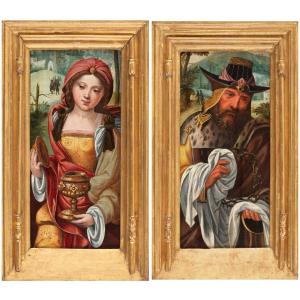The two saints represented on our panels are Joseph of Arimathea and Mary Magdalene whose eyes converge on a central point: a third panel disappeared, our paintings being certainly the side panels of a triptych. Thus, Joseph of Arimathea holds the Holy Crown in the Shroud, in order to collect the blood of Christ which he will later pour into the legendary Holy Grail. At his side, the grieving Mary Magdalene holds her famous attribute: the finely crafted vase containing the perfumes that she used to anoint the feet of Jesus during the Meal at Simon's. These two works are very characteristic of Antwerp mannerism, embodied here in the noble and graceful gestures of the two saints. The perfect face of Marie Madeleine reveals generous cheeks on which run round tears announcing her future penance. The whimsical hat worn by Joseph of Arimathea recalls the treatment reserved for him by Flemish artists of the early Renaissance; moreover, his thin beard enhanced with golden lines is similar to those sported by the adoring Magi of the Nativity triptychs painted by Pieter Coecke van Aelst. In this case, our panels are very similar to the examples kept at the Museum of the Legion of Honor in San Francisco, which, according to art historian Georges Marlier, were to form a triptych with the Descent from the Cross kept in the collection. TG Dowson in Manchester. Our paintings and those of San Francisco show, in the background of each saint, small groups of characters bustling about in a landscape which has however been partially amputated in our version following a rectangle of the panels. The faces of our saints show physiognomic characteristics specific to the art of Pieter Coecke: dimple in the chin and small lips for Mary Magdalene, large beard for Joseph of Arimathea. Nevertheless, some differences can be noticed in the costumes: Marie-Madeleine having abandoned her black doublet for a golden dress made of fine brocade and Joseph of Arimathea sporting here a golden jacket. Notwithstanding these subtle differences, the artist manages to signify the immense sadness which had seized those who, having attended the culminating moments of the Passion, were the first witnesses of the redemption of Original Sin and the establishment of the reign of Grace.
Our two panels are elegantly highlighted by entablature frames in carved and gilded wood.
Dimensions: 52 x 23.5 cm – 67 x 38 cm with frames
Biography: Little is known about the training of Pieter Coecke van Aelst I (Aalst, August 14, 1502 – Brussels, December 6, 1550), except that he would have started his apprenticeship with the Brussels Bernard van Orley. Arrived around 1522 in Antwerp, he married Anna van Dornicke, daughter of the painter Jan van Dornicke in whose studio he would have worked. When the latter died in 1527, he became master of the Guild of Saint Luke in Antwerp. He left for Turkey in 1533, this trip having inspired him to draw a famous series of engravings which he published on his return. Having started to train apprentices in 1529, we know that his three sons worked in his workshop and that he was the master of the very famous Pieter Brueghel the Elder. On his return to Antwerp in 1534, he designed numerous architectural projects for the city, stained glass windows and tapestry cartoons which made him famous and earned him the appointment of Dean of the Guild in 1537. Beyond being a An accomplished artist, Pieter Coecke van Aelst was also a humanist who worked to translate into his own language the founding texts of the First Italian Renaissance, such as Vitruvius's De Architectura. In this respect, Karel van Mander credits the importation of “good construction methods” into the Netherlands which put an end to “the ugly German style”. In 1546, he moved to Brussels where he was appointed painter to the court of Charles V, a title which he would use for the rest of his life in his signatures and which would earn him numerous princely commissions. Having had a prolific workshop, his art was able to spread all the more as it was sometimes taken up in engraving. Thus, his Last Supper of 1531 was transposed into an engraving by the talented Hendrick Goltzius around 1563.
Bibliography:
- MARLIER, Georges, La Renaissance flamande: Pierre Coeck d'Aalost, Bruxelles, Robert Finck, 1966.
- Grand Design: Pieter Coeke van Aelqst and Renaissance Tapestry, Elizabeth Cleland, (exp. cat. New York, Metropolitan, Oct. 8, 2014 – Jan. 11, 2015), Yale University Press, New Haven and London, 2015.
- REAU, Louis, Iconographie de l'Art Chrétien (vol. 2), PUF, 1957.





























 Le Magazine de PROANTIC
Le Magazine de PROANTIC TRÉSORS Magazine
TRÉSORS Magazine Rivista Artiquariato
Rivista Artiquariato
